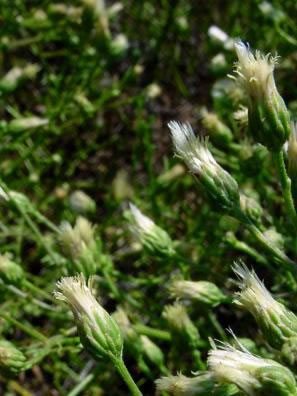Encinitas baccharis facts for kids
Quick facts for kids Encinitas baccharis |
|
|---|---|
 |
|
| Conservation status | |
| Scientific classification | |
| Genus: |
Baccharis
|
| Species: |
vanessae
|
Baccharis vanessae is a special and rare plant found mostly in California. People often call it the Encinitas baccharis. It grows mainly in San Diego County, California, and just a little bit in Riverside County, California. This plant is a key part of the chaparral habitat, which is a type of shrubland common in California.
Because there are so few of these plants left, the United States government has listed it as a threatened species. This means it has special protection to help it survive. There are only about 15 groups of these plants remaining, with around 2,000 individual plants in total. Some of the places where these plants grow might be cleared for new buildings, which is a big worry for their future.
What Does It Look Like?
Baccharis vanessae is a sticky, bushy plant. It has many branches and can grow quite tall, sometimes reaching up to 2 meters (about 6.5 feet) high. Its leaves are long and thin, growing up to 4.5 centimeters (about 1.8 inches) long.
This plant is dioecious (say: dy-EE-shus). This means that male and female flowers grow on separate plants. So, one plant will have only male flowers, and another plant will have only female flowers. After the female flowers are pollinated, they produce a small fruit called an achene. This fruit has a fluffy top, like a dandelion seed, which helps it float away in the wind.
Scientists have also noticed long bumps, called galls, on these plants. These galls are made by certain types of butterflies or moths. This suggests that these insects and the Baccharis vanessae plant have had a close relationship for a very long time.
Why Is It Endangered?
The main reason Baccharis vanessae is in danger is because its home, or habitat, is being destroyed. As more land is developed for homes and businesses, there's less space for these plants to grow.
Another problem is fire suppression. Chaparral areas naturally have wildfires, which can help some plants grow. But when fires are stopped near homes, it can change the natural balance of the habitat. Also, new types of plants, called introduced species, sometimes move into these areas. These new plants can take over and push out the native plants like Baccharis vanessae.
Many of the remaining groups of Baccharis vanessae are very small, with only a few plants. When a group is small, it has less genetic viability. This means the plants might not be as strong or able to adapt to changes, making it harder for them to survive.
Where Did Its Name Come From?
The plant's scientific name, vanessae, was chosen to honor Vanessa Beth Beauchamp. She is the first daughter of the botanist, R.M. Beauchamp, who first described this plant. Her father is now a professor of biology at Towson University in Maryland.
See also
 In Spanish: Baccharis vanessae para niños
In Spanish: Baccharis vanessae para niños


